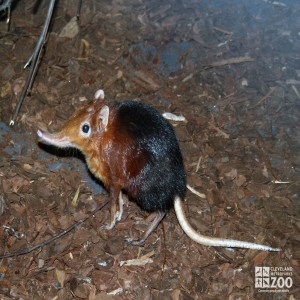Giant Elephant Shrew
[Rhynchocyon petersi]

Despite their name, these animals are neither shrews nor insectivores. These are part of a 'catch-all' order of mammals informally called Afrotherians, which include aardvarks, tenrecs, golden moles, hyraxes, elephants, and manatees. The 'giant' elephant shrew is one of three species of larger elephant shrews. They measure about 11 inches in body length, with a 9- to 10-inch long, naked, rat-like tail. The head and front body is orange-brown, and the rear body is blue-black. The animal has a long flexible nose (hence the name, elephant shrew) and relatively large eyes and ears. It has long, thin legs adapted for rapid running and occasional jumping. Typical weight is a little over one pound.
Location: Animals Formerly at Zoo
Share:
Range
The range of the giant elephant shrew is east Africa, in a relatively restricted range in Kenya and Tanzania.
Habitat
Giant elephant shrews inhabit deep forest from sea level to mountain slopes.
Conservation Status
Least ConcernPrimary Threats
Gestation
Gestation lasts less than 2 months.
Litter
Generally a single offspring
Behavior
The giant elephant shrew is diurnal, spending the daylight hours hunting for food in leaf litter. Birds of prey and snakes are these shrews predators. They are monogamous and form life-long breeding pairs. Outside of breeding, however, the animals spend little time together. The elephant shrew will defend its territory against intrusions of other elephant shrews. The male will battle a male intruder, the female will battle a female. A scent gland at the base of the tail is used to mark territories and food trails. The elephant shrew has a keen sense of smell, hearing, and sight.
Reproduction
After a gestation period of perhaps 6 weeks, the female giant elephant shrew gives birth to a single baby that is generally well developed and covered with hair. Weaning is complete in about two weeks. The female can give birth to 4 or 5 litters a year. The most remarkable fact of the breeding relationship is the parents’ monogamous attachment for life. Mating is brief and males do not assist with raising the young.
Wild Diet
Mostly ants, termites, crickets, plus other small invertebrates
Zoo Diet
Cat food
